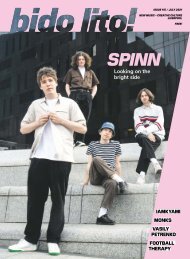Issue 113 / April-May 2021
April-May 2021 issue of Bido Lito! magazine. Featuring: PIXEY, AYSTAR, SARA WOLFF, DIALECT, AMBER JAY, JANE WEAVER, TATE COLLECTIVE, DEAD PIGEON GALLERY, DAVID ZINK YI, SAM BATLEY, FURRY HUG, FELIX MUFTI-WRIGHT, STEALING SHEEP and much more.
April-May 2021 issue of Bido Lito! magazine. Featuring: PIXEY, AYSTAR, SARA WOLFF, DIALECT, AMBER JAY, JANE WEAVER, TATE COLLECTIVE, DEAD PIGEON GALLERY, DAVID ZINK YI, SAM BATLEY, FURRY HUG, FELIX MUFTI-WRIGHT, STEALING SHEEP and much more.
Create successful ePaper yourself
Turn your PDF publications into a flip-book with our unique Google optimized e-Paper software.
A new public-facing<br />
exhibition, commissioned and<br />
curated by Tate Collective,<br />
will feature images of<br />
Merseyside and the North<br />
West displayed on billboards<br />
across Liverpool. Featuring<br />
landscape, portrait and<br />
documentary photography<br />
submitted by those aged<br />
16-25, the collection of<br />
images looks to build on<br />
the work of Don McCullin<br />
and highlight the social<br />
intricacies of the region.<br />
Leah Binns takes a closer<br />
look at the works in question.<br />
Isolation - Callum Cole<br />
NORTH W<br />
Since normal life as we know it has been<br />
uprooted and as lockdown rules and statistics<br />
continue to fluctuate, the coronavirus pandemic<br />
has changed how we interpret imagery;<br />
an emptied landscape, or a lone figure, has come to<br />
represent a stronger feeling of solitude than it did before.<br />
Photography taken at this time takes on a certain<br />
quality, and there is a new framework for understanding<br />
the world that reflects this tenuous and difficult period<br />
of collective responsibility. Perhaps fitting for the way<br />
in which we are continually adjusting to shifts in life’s<br />
parameters, a current exhibition at Tate Liverpool<br />
captures moments of social unrest, ranging from the<br />
industrial North to international conflict, by British<br />
photographer Don McCullin.<br />
The images draw on very timely ideas of political<br />
upheaval, as well as smaller moments that reflect the<br />
everyday life of the subjects. Purposefully confrontational<br />
and resistant, McCullin’s images push at the boundaries<br />
of the viewer’s ethics, presenting scenes of poverty and<br />
war with disturbing clarity.<br />
Following a Tate Collective open call, billboards<br />
across Liverpool will be filled with photographs from<br />
young creatives inspired by McCullin’s work. Members<br />
from the Tate Collective scheme, which is free to join<br />
and open to all 16-25-year-olds, were invited to submit<br />
photographs in response to the exhibition. In addition<br />
to gallery discounts and £5 exhibition tickets, the Tate<br />
Collective scheme gives access to free events and<br />
creative opportunities, such as this ‘photographing the<br />
North West’ open call.<br />
From all of the submissions, 30 images have been<br />
selected to appear on billboards throughout the city from<br />
7th <strong>April</strong> and will be shown in the studio at Tate Liverpool<br />
once the gallery is able to reopen later in <strong>May</strong>. The open<br />
call was created by Tate Collective Producers, a group of<br />
16-25-year-olds working with Tate to curate events and<br />
opportunities for young people.<br />
The thread that connects the images is the spirit of<br />
the North West, through its communities, culture, and<br />
landscape. While the results were wide-reaching, many<br />
themes are recurrent, showing the persistence of certain<br />
feelings in our collective consciousness; from isolation and<br />
escapism, to community and protest. Some images explore<br />
new understandings of landscape during lockdown, while<br />
others touch on the North West’s playfulness, civic pride,<br />
artistic outlook, or political histories.<br />
Tate Collective Producers, Laura Wiggett and Niamh<br />
Tam, who helped create the project, note how they<br />
prioritised providing a platform for young creatives who are<br />
currently being left stranded by<br />
the lack of opportunities in the art<br />
world. Breaking with the current<br />
tendency for works and events<br />
to move online, Laura highlighted<br />
how the producers wanted<br />
“something physical to have”.<br />
As a public-facing billboard<br />
project, a different understanding<br />
of scale and space that is<br />
disconnected from exhibition<br />
conventions was necessary,<br />
which opened up new challenges<br />
for the producers themselves.<br />
Laura stressed the importance of<br />
making the exhibition “accessible for everyone”, both for<br />
its contributors and in its reception. More sporadic than<br />
a conventional exhibition, and framed by the city itself,<br />
the project has the opportunity to directly exist within the<br />
space it seeks to reflect.<br />
“Looking at themes of protest through McCullin’s war<br />
imagery, looking at landscapes through his images of<br />
Liverpool, the images that we’ve chosen are a really good<br />
reflection of the exhibition itself,” says Niamh.<br />
“These images<br />
follow in McCullin’s<br />
footsteps by<br />
exposing the<br />
histories embedded<br />
in the landscape”<br />
The influence of McCullin’s landscapes is particularly<br />
apparent in some images that are energetic natural<br />
scenes with dynamic compositions. Photographs such as<br />
Safe Travels, Neston and Thurstaston Beach respond to<br />
a shift in our relationship to the local area, whether that<br />
be a sense of absence as implied by our loss of a daily<br />
commute, or a renewed interest in nature through daily<br />
walks in lockdown. Safe Travels, Neston balances a sparse<br />
scenic view with a lively flock of birds. Thurstaston Beach,<br />
on the other hand, is far darker, with a more rocky, textured<br />
feel, almost ghostly in how it is laden with gloom.<br />
“Despite what it suggests,” says George Jones, the<br />
photographer of the image, “the coast is often packed<br />
with locals enjoying the smell<br />
of the salty air, the joyous<br />
atmosphere, or the vastness<br />
of the sea at the mouth of<br />
the Mersey. Hopefully what<br />
Thurstaston Beach does signify<br />
is the intertwining and treasured<br />
relationship our local landscapes<br />
have with their people.”<br />
Discussing the influence<br />
of McCullin, Jones adds: “What<br />
I found exceptional about his<br />
landscapes, having come after<br />
the intense, excruciating images<br />
of conflict, was the space and<br />
expansiveness they possessed. The skies specifically<br />
were so visceral, so epic, almost at times apocalyptic.”<br />
For many, a daily walk in nature has come to<br />
symbolise a way of sustaining normalcy, or routine,<br />
through unusual times. The image of Thurstaston Beach<br />
definitely reflects this; there is a sense of catharsis in its<br />
vigour, in how it draws on expansive space as an antidote<br />
to the confinement of lockdown.<br />
Other images represent urban rather than natural<br />
26

















